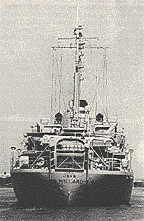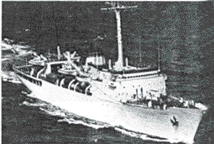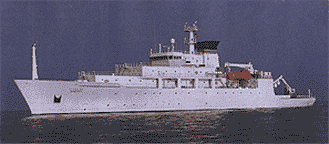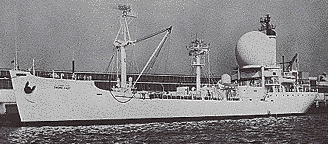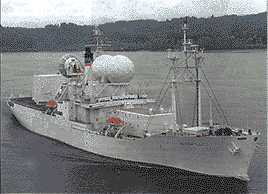Special Missions of Military Sea Transportation Service and Military Sealift Command
By Salvatore R. Mercogliano
High in orbit, two of America's leading astronauts were gripped in a life-or-death struggle. A stuck thruster valve hurled their spacecraft into an unexpected tumble and they needed to make contact with NASA (National Aeronautics and Space Administration) flight control. If their spiral continued, they faced the possibility of blacking out due to the G-forces and plummeting to their deaths in an uncontrolled re-entry through the atmosphere.
In the Philippine Sea, the range instrumentation ship USNS Coastal Sentry served as an at-sea surrogate for NASA flight control. On board, in addition to its crew of merchant mariners, NASA and Air Force technicians tracked the craft in its voyage. Manning the capsule command (Capcom) seat, James R. Fucci made contact with the spacecraft.
The astronauts reported serious problems and they could not control the ship. Fucci maintained communications with the astronauts while they shut down their thruster controls and switched to the reentry control system, thereby regaining command of their ship. With their reentry system activated, the Capcom relayed immediate instructions to make an emergency splashdown. The USNS Coastal Sentry, along with the USNS Rose Knot demonstrated the flexibility of mobile seaborne communication systems to NASA and the two astronauts.
Landing in the Pacific Ocean, both astronauts would later return to space, David Scott as the command module pilot in Apollo 9, and then commander of Apollo 15. The commander of Gemini 8, Neil Armstrong became the first man to step foot on the Moon in Apollo 11 three years later.
MSTS Expands Its Role
Nearly ten years after its formation, the Military Sea Transportation Service expanded its original mission with the inclusion of several unique ships into its inventory. MSTS had proved itself to be adaptive to contingencies during its initial operating years. In 1958, the Navy transferred an ex-salvage ship, the USS Chain to the service for conversion and use as an oceanographic research ship.
Joining the fleet in November of that year, the ship embarked 28 oceanographers and scientists from the Woods Hole Oceanographic Institute under the direction of the Office of Naval Research. Commanded by Captain Wallace Olivey, the USNS Chain became the first of a fleet of ships operated by MSTS and MSC for unique missions and services and originally known as the Special Projects Branch, and later redesignated Special Missions.
USNS Josiah Willard Gibbs Oceanographic Research ShipHydrographic Survey Ships
On January 1, 1959, Chief of Naval Operations Arleigh Burke endorsed a long-range program of oceanographic research, known as the Ten-year Ocean Study (TENOC). The impetus for the study, while having scientific merit also masked a definite military objective. The advent of nuclear powered submarines sparked a revolution in naval warfare. No longer would submarines have to surface to recharge batteries and replenish their air supply.
These attributes required a more extensive knowledge of what lay below the oceans surface, such as sub-surface currents and rivers, thermoclines, salinity gradients, gravimetric fluctuations, and the basic contours of the ocean floor, beyond the normal 30-fathom line. In 1959, the USS George Washington, the first nuclear-armed ballistic missile submarine entered the fleet. Based at Holy Loch, Scotland, the Navy required accurate charts for that area and the operation of follow-on boats.
In response to this, MSTS converted three Victory-class freighters into the first civilian-manned Hydrographic Survey Ships. Affectionately known as "The Triplets," the USNS Dutton, Bowditch, and Michelson entered service in late 1958, and immediately embarked on a 34-month survey mission to chart the deep-water environs around Europe. Today MSC operates a force of 8 ships designed to incorporate the missions of the "Triplets" and ships like the Chain into a few multi-purpose platforms.
USNS Chauvenet Hydrographic Survey Ship (1970-92)
USNS Bowditch Oceanographic Ship (1996-present)In the early 1990s two coastal survey ships, USNS John McDonnell and Littlehales, entered the fleet, replacing the British-built Chauvenet and Harkness. Today, the six-ship Pathfinders are phasing out the last of the Silas Bent-class of survey ships built in the late 1960s along with the replacements for the "Triplets," USNS Hess, Maury, and Tanner. New Oceanographic Research Ships, operated by academic and maritime institutions supplanted the older Conrad-class.
Range Instrumentation Ships
While MSC's Oceanographic Survey Ships remain a facet of the fleet, the force of twenty-three Range Instrumentation Ships has diminished greatly. At nearly the same time that the USNS Chain joined the fleet, MSTS began to convert some of its surplus cargo ships into support vessels to replace Navy-manned ships for the Pacific Missile Test Range. Initially 8 ships composed the West Coast force, while on the East Coast, the U.S. Air Force operated its own independent fleet for the Eastern Missile Test Range at Cape Canaveral. These 10 ships, managed by Pan American Airways, performed a similar function, and this duplication of effort remained in place till the ships were transferred to MSTS in July 1964.
USNS Sword Knot Range Instrumentation Ship C1-M-AV1However, this coincided with the initial sealift mission to Vietnam, and so as to alleviate the need to replace the merchant crews with civilian mariners, MSTS negotiated with the two companies operating its tankers to include these ships under their contracts for one year. With this large a force, MSTS immediately set out to lay up ships no longer needed and optimize the use of the remaining vessels.
The conclusion of the Apollo program, along with the introduction of satellite communication and improved shore-based tracking systems lessened the need for these ships and today only the USNS Observation Island, and the converted ocean surveillance ship USNS Invincible (T-AGM 24) provide at-sea monitoring of ballistic missile testing.
USNS Observation Island used to monitor ballistic missile testingMiscellaneous Auxiliary
As the Special Projects Branch grew, MSTS began to operate another diverse and varied group of ships. In Navy nomenclature, a vessel that performs a function that does not fit into any particular classification is known as a Miscellaneous Auxiliary, or AG. In 1960, the veteran tanker USNS Mission Capistrano underwent an extensive shipyard conversion.
As part of Project Artemis, the Office of Naval Research fitted the ship with a five-stories-high sonar transducer which could be lowered through an amidships well. Conceived by Dr. Frederick V. Hunt of Harvard University, the concept was that the ship could use its high-power sonar in an area surrounded by hydrophones to locate a submerged submarine, a precursor to some of today's modern naval sonar devices.
Many other T-AGs have joined the fleet over the years, ranging from the satellite communication relay ship Kingsport, to the Hayes that performs acoustic sonar tests with Navy submarines.
From a small beginning in 1958, the fleet peaked at 46 ships in 1969, and stood at 29 on MSC's 50th anniversary. The assignments given to the ships in Special Missions have proven as diverse and varied as the ships and crews employed by the command.
First Female Mariner at MSC
Special Missions also provided the platform to allow MSC to break down the gender barrier. In June 1978, Third Mate Karen McGee, a graduate of SUNY Maritime College [State University of New York at Fort Schuyler, Bronx, NY], reported aboard the oceanographic survey ship USNS Kane as the first licensed female mariner permanently employed by the command.
Contract Operation
In 1984, the fleet underwent a transformation with the introduction of contract-operation under the direction of the A-76 circular from the Office of Budget Management. The need to lower costs, along with a declining commercial merchant marine, and the growth of the Naval Fleet Auxiliary Force, provided an additional impetus to transfer some of the operations to private shipping firms. That next year, Lavino Shipping of Philadelphia won the contract to operate 12 survey ships for MSC with non-Civmar crews.
Today, contract operations of Special Mission ship is the norm, with only a few retaining civilian mariners. While many view Special Missions as an ancillary mission to the Military Sealift Command, the men and women who have served on these ships have performed unique and strategically important assignments for the national defense of this nation.
List of Special Missions Ships
Illustrations from:
Military Sea Transportation Service, NAVPERS 10829-B, Bureau of Naval Personnel, Washington, DC: U.S. Government Printing Office, 1962
From America to United States: The History of the long-range Merchant shipbuilding Programme of the Unites States Maritime Commission (1937-1952) Part 3, L.A. Sawyer and W.H.Mitchell London: World Ship Society, 1979
Sealift, November 1973, Military Sealift Command
Sealift, September 1996, Military Sealift Command
Sealift, October 1996, Military Sealift Command
www.USMM.org is grateful to Professor Salvatore R. Mercogliano for providing this article. Mercogliano is writing his doctoral dissertation about the history of the Merchant Marine, Military Sea Transportation Service and Military Sealift Command.MSC Ships of the Line by Salvatore R. Mercogliano
MSTS and MSC Operations Other Than War by Salvatore R. Mercogliano
MSC Ships that Wait by Salvatore R. Mercogliano
Home11/29/00
www.USMM.org ©1998, 1999, 2000 Salvatore R. Mercogliano and. You may quote material on this web page as long as you cite American Merchant Marine at War, www.usmm.org, as the source. You may not use more than a few lines without permission. If you see substantial portions of this page on the Internet or in published material please notify usmm.org @ comcast.net
